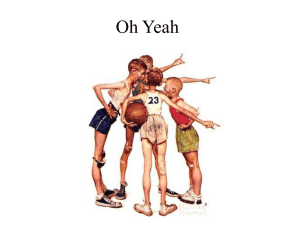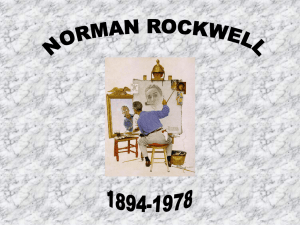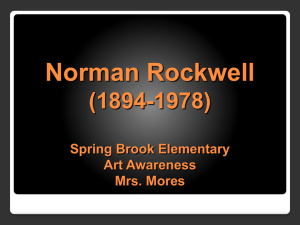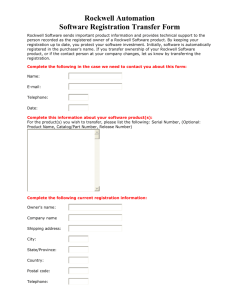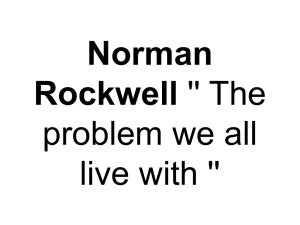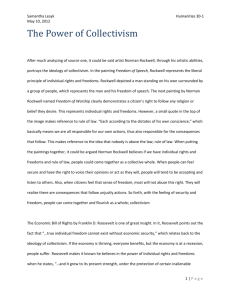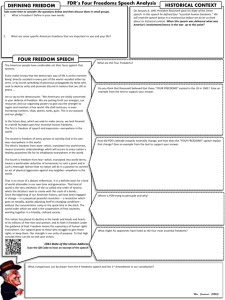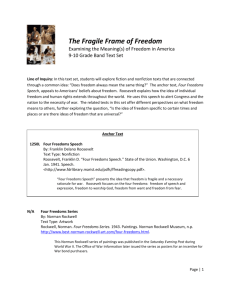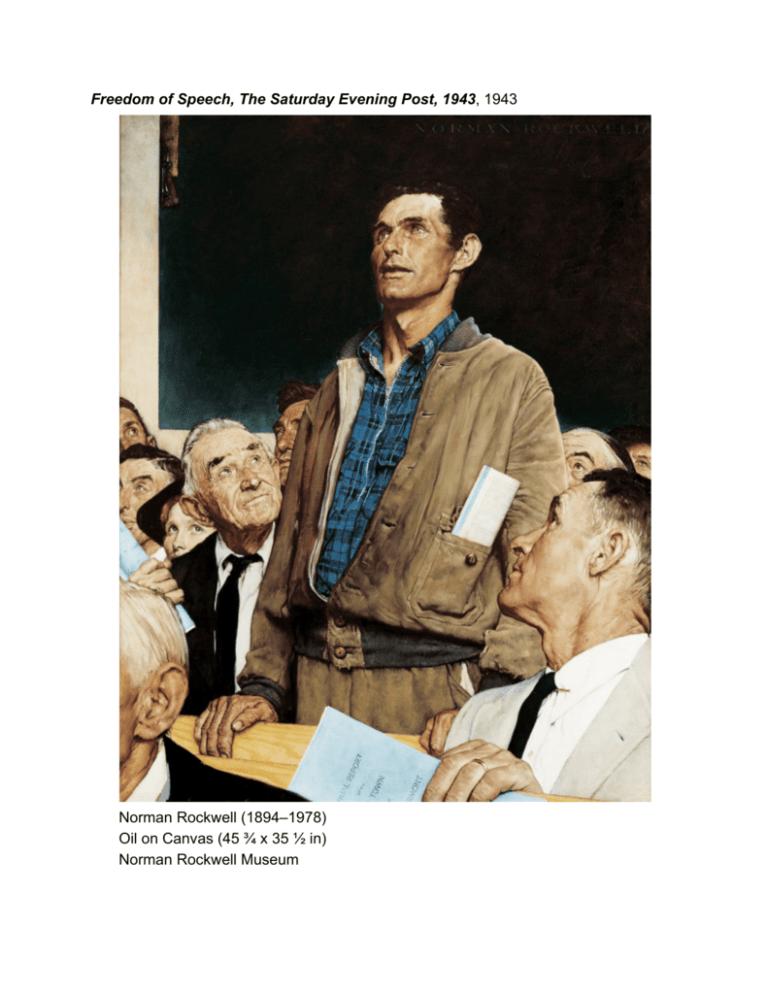
Freedom of Speech, The Saturday Evening Post, 1943, 1943
Norman Rockwell (1894–1978)
Oil on Canvas (45 ¾ x 35 ½ in)
Norman Rockwell Museum
Source: Educator Resource Book, Picturing America, pp. 82-83.
http://picturingamerica.neh.gov/downloads/pdfs/Resource_Guide_Chapters/PictAmer_Resource_Book_Chapter_19A.pdf
NORMAN ROCKWELL [1894 –1978]
19 a Freedom of Speech, The Saturday Evening Post, 1943
After Japan attacked Pearl Harbor on December 7, 1941,
America was soon bustling to marshal its forces on the home
front as well as abroad. Norman Rockwell, already well known
as an illustrator for one of the country’s most popular magazines, The Saturday Evening Post, had created the affable, gangly
character of Willie Gillis for the magazine’s cover, and Post readers eagerly followed Willie as he developed from boy to man
during the tenure of his imaginary military service. Rockwell
considered himself the heir of the great illustrators who left their
mark during World War I, and, like them, he wanted to contribute something substantial to his country.
A critical component of the World War II war effort was the
creation of visual images based on Franklin D. Roosevelt’s
appeal to the four essential human freedoms he spoke about in
his State of the Union address on January 6, 1941 — freedom
of speech and expression, freedom from want, freedom from
fear, and freedom of worship. Yet, by the summer of 1942,
two-thirds of Americans still knew nothing about the Four
Freedoms, even though government agencies had disseminated
photographs, prints, and even a textile design referring to them.
It is unclear whether Rockwell or a member of the Office of
War Information suggested he take on the Four Freedoms.
19-A Norman Rockwell (1894 – 1978), Freedom of Speech,
The Saturday Evening Post, February 20, 1943. Oil on canvas,
453⁄4 x 351⁄2 in. (116.205 x 90.170 cm.). The Norman Rockwell Art
Collection Trust, Norman Rockwell Museum, Stockbridge, Mass.
www.nrm.org ©1943 Norman Rockwell Family Entities. Printed
by permission of the Norman Rockwell Family Agency.
82
What is uncontested is that his renditions were not only vital to
the war effort, but have become enshrined in American culture.
Painting the Four Freedoms was important to Rockwell for
more than patriotic reasons. He hoped one of them would
become his statement as an artist. Rockwell had been born into
a world in which painters crossed easily from the commercial
world to that of the gallery, as Winslow Homer had done
(see 9-A). By the 1940s, however, a division had emerged
between the fine arts and the work for hire that Rockwell produced. The detailed, homespun images he employed to reach
a mass audience were not appealing to an art community that
now lionized intellectual and abstract works. But Rockwell knew
his strengths did not lie in that direction: “Boys batting flies on
vacant lots,” he explained in 1936, “little girls playing jacks on
the front steps; old men plodding home at twilight, umbrella in
hand — all these things arouse feeling in me.”
Rockwell’s ability to capture something universal in the commonplace is behind the success of the Four Freedoms pictures.
For Freedom of Speech, the first painting he completed, the artist
attempted four different compositions in which a man dressed
in work clothes, the community’s “Annual Report” folded in his
pocket, stands to give his opinion at a New England town
meeting. In this, the final version, Rockwell depicts him from
slightly below eye level, encircled by his fellow townspeople
and by us, the viewers, who take our place two benches in
front of him. The timeless properties of this work are the result
of Rockwell’s classical sense of composition: the speaker stands
at the apex of a pyramid drawn by the upward glances of his
neighbors. The warm, light tones of the speaker’s skin glow
against the matte black chalkboard in the background, giving him
a larger-than-life, heroic appearance. The work also exudes a
sense of immediacy. A snapshot effect is achieved by the inclusion of fragmented forms at the painting’s borders: the partial
head of the man in the lower left and the glimpse of two faces
in the right and left back corners (the one on the left is
Rockwell’s own). Rockwell’s eye for detail (he used ordinary
people as models and had scores of photographs made before
beginning to paint in order to remind him of things as small as a
folded collar) gives each inch of the painting a sense of the
accidental and familiar.
In 1943, the four canvases were published in The Saturday
Evening Post before being sent on a nationwide tour called the
“Four Freedoms War Bond Show.” More than a million people
saw them in sixteen cities and over 133 million dollars in war
bonds were sold. This painting — Rockwell felt it and Freedom
to Worship were the best of the four — helped galvanize the
nation to action during the war. Long after that conflict, its message continues to resonate; time has revealed that the value of
the Four Freedoms series lies not simply in the ideas it presented, but in Rockwell’s exceptional ability as an artist.
PICTURING AMERICA ARTWORK, ESSAYS, AND ACTIVITIES
Encourage students to study this painting carefully.
DESCRIBE AND
ANALYZE
E|M|S
Ask students what these people are doing.
The standing man is speaking and others are looking and listening to him.
Have students find the words TOWN and REPORT.
They are located on blue paper near the lower edge.
Where might these people be?
They are attending a community meeting. Because MONT is visible on the paper, it may be a town meeting in Vermont.
Ask students to describe the expression on the speaker’s face.
He seems very intent and serious. He looks up as if he is speaking to someone above him.
Ask students to describe the textures and patterns of the standing man’s clothes and hands. Have them compare his
hands and clothing with that of the other men. What do their hands and clothing suggest about their professions and
financial status?
The speaker wears a slightly rumpled, zippered, plaid shirt and frayed jacket. The other men wear smooth, white buttoned shirts,
ties, and suit jackets. The speaker’s hands are darker and rougher than the lighter, smoother hand of the man on his right. The
speaker is probably a manual laborer and the others, wealthier businessmen.
In what ways does this scene seem real?
The closely observed details and the composition with some faces only partially shown are almost like a photograph.
Who is attending this meeting?
We see young and old men and a woman in a black hat.
Who is the youngest man? The speaker is.
How do you know? His hair is dark rather than gray and his face isn’t as wrinkled as the others’.
Describe the reaction of the other people in this scene to the speaker.
They are all listening respectfully to him.
How did Rockwell emphasize the speaker?
His light face contrasts with a plain black background. Light shines on his forehead and most of the people are looking at him.
M|S
Where is the viewer of this scene?
The viewer is seated two rows in front of the speaker, looking up at him.
How does this viewpoint influence our understanding of how Rockwell felt about this man and what he was doing?
We look up to this man, making him seem important.
INTERPRET
E|M|S
Encourage students to imagine what the speaker might be saying. Discuss recent town meetings or hearings
in your community where citizens voiced their opinions.
teaching activities
TEACHING ACTIVITIES
E = ELEMENTARY| M = MIDDLE |S = SECONDARY
M|S
What is the paper in the speaker’s pocket?
It is probably a town report.
Because the men in this scene have town reports, what does Rockwell assume about Americans and their form of
government?
Ordinary American citizens can read and are capable of understanding complex issues concerned with government.
What inspired this painting?
Franklin D. Roosevelt’s 1941 State of the Union address. Roosevelt appealed to four essential human freedoms.
Explain why this scene shows an American freedom. Why did Americans believe there was a connection between this
image and World War II?
An ordinary working-class American citizen is able to voice his opinions without fear of censorship. Americans were fighting
totalitarian dictatorships that did not allow this freedom of speech.
CONNECTIONS
Historical Connections: World War II;
Civics: Bill of Rights; U.S. Supreme
war bonds; Pearl Harbor
Court cases: Whitney v. California,
Stromberg v. California, Brandenburg
v. Ohio, and New York Times Co.
v. United States; structure and
function of local government
Historical Figures: Franklin Delano
Roosevelt; Dwight D. Eisenhower;
Winston Churchill; Adolph Hitler
F R E E D O M O F S P E E C H, T H E S AT U R DAY E V E N I N G P O S T, 1 9 4 3 , NORMAN ROCKWELL [1894–1978]
Literary Connections and Primary
Documents: “Four Freedoms”
speech, Franklin Delano Roosevelt
(secondary); “Death of the Ball Turret
Gunner,” Randall Jarrell (secondary)
83
Bruce Cole on Norman Rockwell's Masterpiece Painting Freedom of Speech - WSJ.com
10/25/11 6:20 PM
Dow Jones Reprints: This copy is for your personal, non-commercial use only. To order presentation-ready copies for distribution to your colleagues, clients or
customers, use the Order Reprints tool at the bottom of any article or visit www.djreprints.com
See a sample reprint in PDF format.
MASTERPIECE
Order a reprint of this article now
OCTOBER 10, 2009
Free Speech Personified
Norman Rockwell's inspiring and enduring painting
By BRUCE COLE
Ahundred thousand people came to see them in Washington and New York, a million more in other major cities
across the country. They were visited by a vice president, stars of screen and radio, and even survivors of the
Bataan "Death March." They raised millions of dollars for the purchase of war bonds, and were reproduced in
over four million copies.
Sponsored by the Treasury Department and the Saturday
Evening Post, the 1943 "Four Freedoms War Bond Exhibition"
was our first national "blockbuster." Exhibited not in museums
or galleries, but in department stores for a year during the
depths of World War II, it made an already well-known
illustrator a household name.
What the crowds came to see were paintings: "Freedom of
Speech," "Freedom of Worship," "Freedom From Want" and
"Freedom From Fear" (now all prominently displayed in the
Norman Rockwell Museum). In 1943 each had been
reproduced, along with an accompanying essay by leading
literary lights including Booth Tarkington and Stephen Vincent
Ben�t, in successive issues of the Saturday Evening Post, a
popular magazine for which Norman Rockwell had worked
since 1916.
�1943 SEPS: Licensed by Curtis Publishing, Indianapolis,
IN From the permanent collection of Norman Rockwell
Museum
"Freedom of Speech," Norman Rockwell, 1943. Oil on
canvas, 45 3/4" x 35 1/2". Story illustration for "The
Saturday Evening Post," February 20, 1943. On view
at the Norman Rockwell Museum.
Rockwell discovered his subjects in Franklin Roosevelt's State
of the Union speech of Jan. 6, 1941, delivered 11 months before
Pearl Harbor. In it, the president warns of the looming danger
posed by aggressor nations, proposes Lend-Lease, and calls for
a major increase in armament production. At the speech's
conclusion he looks toward the future, to a world founded upon
"four essential freedoms."
"Freedom of speech and expression" and "freedom of worship"
are, of course, from the Bill of Rights. But the other
two?"freedom from want" and "freedom from fear," which the
president defines as "a world-wide reduction of armaments to such a point . . . that no nation will be in a
position to commit an act of physical aggression against any neighbor"?are Roosevelt's, or perhaps his wife
Eleanor's, utopian wishes for universal rights that were to become part of the United Nations Charter.
As a superb illustrator who used the familiar world of his viewers to tell them stories with messages that
touched their hearts, Rockwell said in his autobiography that he had difficulty conceptualizing the abstract, and
internationalist, Four Freedoms, especially the negative rights of "want" and "fear": "I never liked 'Freedom
from Fear' or, for that matter, 'Freedom from Want,'" he wrote. "Neither of them," Rockwell thought, "had any
http://online.wsj.com/article/SB10001424052970203440104574406903628933162.html#printMode
Page 1 of 2
Bruce Cole on Norman Rockwell's Masterpiece Painting Freedom of Speech - WSJ.com
10/25/11 6:20 PM
from Fear' or, for that matter, 'Freedom from Want,'" he wrote. "Neither of them," Rockwell thought, "had any
wallop." He was right.
"Freedom From Want" depicts a homey Thanksgiving dinner; it's more about what we have than what we want,
surplus rather than scarcity. In "Freedom Fom Fear," a mother tucks in her children while her husband holds a
newspaper with headlines reading "Bombings" and "Horror." This reference to the war is so specific that it
conveys little about fear or Roosevelt's plan for universal disarmament. Rockwell just could not get his hands
around these airy abstractions.
And, although he was proud of "Freedom of Worship," his
depiction of spectral close-up faces and hands raised in prayer
is bland, without any real message about religious freedom?
again, no wallop. This is because faith, like the absence of fear
and the absence of want, is essentially private, something
personal, intangible and unpicturable.
In "Freedom of Speech," however, Rockwell found a subject
that is active and public, a subject he could grasp and shape
into his greatest painting forging traditional American
illustration into a powerful and enduring work of art.
For inspiration, he thought of the New England town-hall
meetings he knew so well, with their long tradition of
democratic public debate?a tradition, as we have seen this
summer, still very much alive. But we are not sure where
Rockwell's scene occurs; a blackboard frames the speaker, but
he stands behind a pew: school and church, two pillars of
American life. The pamphlet held by the man closest to us
reveals the subject of the meeting?a discussion of the town's
annual report.
�1943 SEPS: Licensed by Curtis Publishing, Indianapolis,
IN From the permanent collection of Norman Rockwell
Museum
Using a classic pyramidal composition, Rockwell focuses
attention on the standing speaker whose age, worn and stained
"Freedom from Fear," Norman Rockwell, 1943. Oil on
jacket, rough hands with dirty fingernails, and plaid shirt set
canvas, 45 3/4" x 35 1/2". Story illustration for "The
him apart from the neat coats, ties and white shirts of the older
Saturday Evening Post," March 13, 1943. On view at
the Norman Rockwell. Museum
men in the audience. Although he is a working man, this figure,
his face reminiscent of Lincoln's, is unafraid to voice his
opinion?which we suspect is contrary to that of the others in the room. Standing tall, his mouth open, his
shining eyes transfixed, he speaks his mind, untrammeled and unafraid. In Rockwell's vision he has become not
only an active public participant in democracy, but a defender of it. He is the very embodiment of free speech, a
living manifestation of that abstract right?an image that transforms principle, paint and, yes, creed, into an
indelible image and a brilliant and beloved American icon still capable of inspiring millions world-wide.
—Mr. Cole, an art historian and former chairman of the National Endowment for the Humanities, is president of the
American Revolution Center at Valley Forge, Pa.
Copyright 2011 Dow Jones & Company, Inc. All Rights Reserved
This copy is for your personal, non-commercial use only. Distribution and use of this material are governed by our Subscriber Agreement and
by copyright law. For non-personal use or to order multiple copies, please contact Dow Jones Reprints at 1-800-843-0008 or visit
www.djreprints.com
http://online.wsj.com/article/SB10001424052970203440104574406903628933162.html#printMode
Page 2 of 2
Powers of Persuasion
Introduction
About this Exhibit
We look forward to a world founded upon four essential human freedoms. The
first is freedom of speech and expression--everywhere in the world. The
second is freedom of every person to worship God in his own way-- everywhere
in the world. The third is freedom from want . . . everywhere in the world. The
Man the Guns!
It`s a Woman`s War Too!
United We Win
Use it Up, Wear it Out
Four Freedoms
Warning! Our Homes
Are in Danger Now!
This is Nazi Brutality
He`s Watching You
He Knew the Meaning
of Sacrifice
Stamp `Em Out!
fourth is freedom from fear . . . anywhere in the world.
--President Franklin D. Roosevelt, Message to Congress, January 6, 1941
President Roosevelt was a gifted communicator. On January 6, 1941, he addressed
Congress, delivering the historic "Four Freedoms" speech. At a time when Western Europe lay
under Nazi domination, Roosevelt presented a vision in which the American ideals of individual
liberties were extended throughout the world. Alerting Congress and the nation to the necessity
of war, Roosevelt articulated the ideological aims of the conflict. Eloquently, he appealed to
Americans` most profound beliefs about freedom.
The speech so inspired illustrator Norman Rockwell that he created a series of paintings on the
"Four Freedoms" theme. In the series, he translated abstract concepts of freedom into four
scenes of everyday American life. Although the Government initially rejected Rockwell`s offer
to create paintings on the "Four Freedoms" theme, the images were publicly circulated when
The Saturday Evening Post, one of the nation`s most popular magazines, commissioned and
reproduced the paintings. After winning public approval, the paintings served as the
centerpiece of a massive U.S. war bond drive and were put into service to help explain the
war`s aims.
You can hear this excerpt from President Roosevelt`s address (920K WAV File). [Download
WAV] Text
Save Freedom of Speech
By Norman Rockwell
©1943 SEPS: The Curtis Publishing Co.,
Agent
Printed by the Government
Printing Office
for the Office of War Information
NARA Still Picture Branch
(NWDNS-208-PMP-44)
(Click on poster for high-resolution image)
http://www.archives.gov/exhibits/powers_of_persuasion/four_freedoms/four_freedoms.html
Powers of Persuasion
Save Freedom of Worship
By Norman Rockwell
©1943 SEPS: The Curtis Publishing Co.,
Agent
Printed by the Government
Printing Office
for the Office of War Information
NARA Still Picture Branch
(NWDNS-208-PMP-43)
(Click on poster for high-resolution image)
Ours...to fight for-Freedom From Want
By Norman Rockwell
©1943 SEPS: The Curtis Publishing Co.,
Agent
Printed by the Government
Printing Office
for the Office of War Information
NARA Still Picture Branch
(NWDNS-208-PMP-45)
(Click on poster for high-resolution image)
Ours...to fight for-Freedom From Fear
By Norman Rockwell
©1943 SEPS: The Curtis Publishing Co.,
Agent
Printed by the Government
Printing Office
for the Office of War Information
NARA Still Picture Branch
(NWDNS-208-PMP-46)
(Click on poster for high-resolution image)
http://www.archives.gov/exhibits/powers_of_persuasion/four_freedoms/four_freedoms.html

